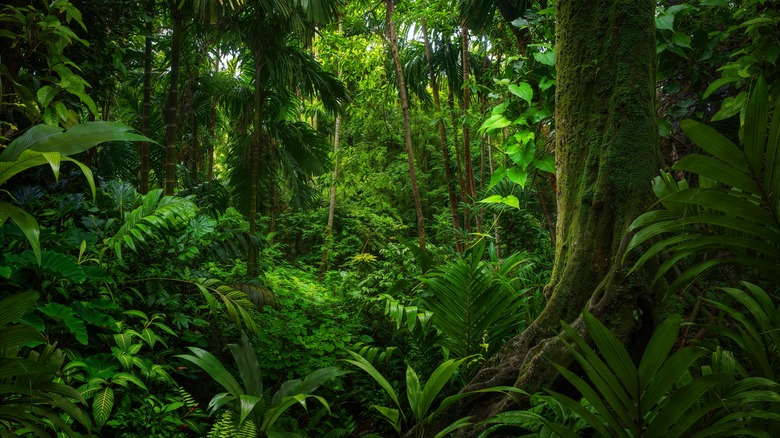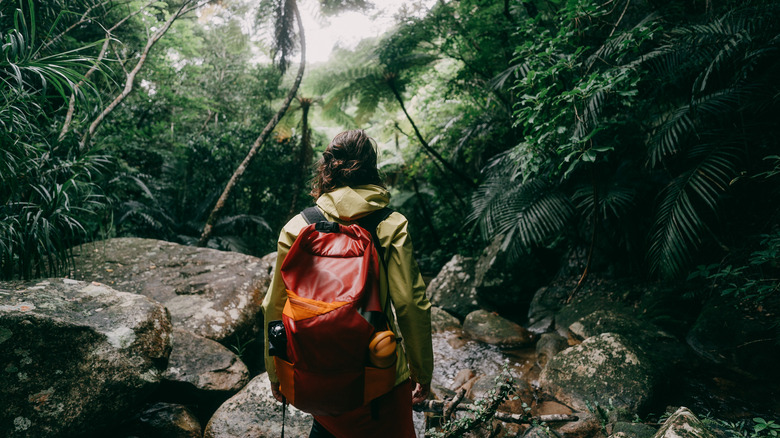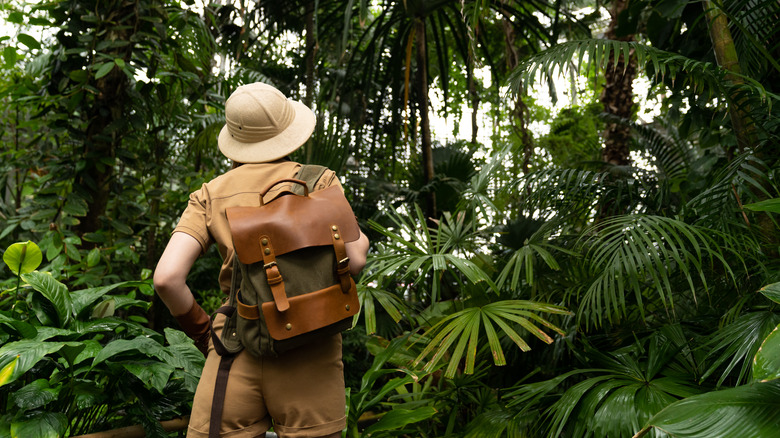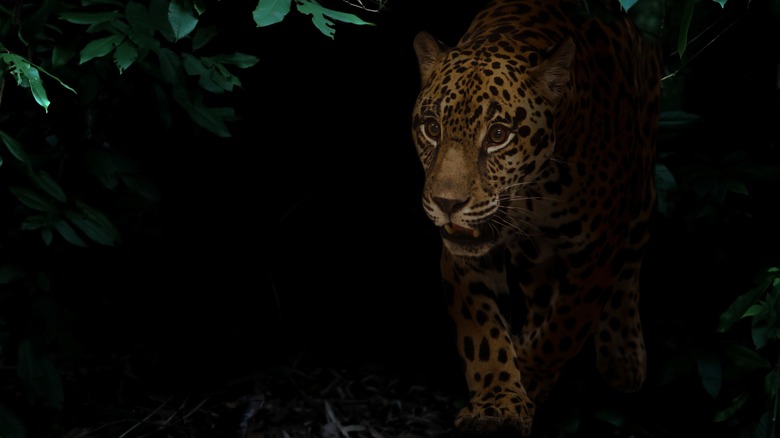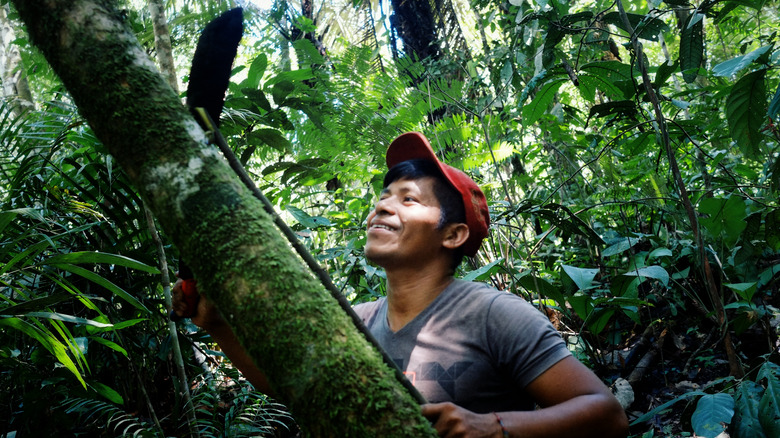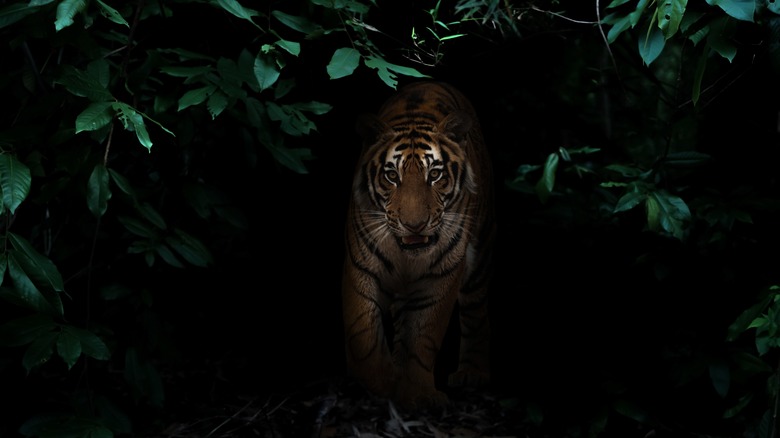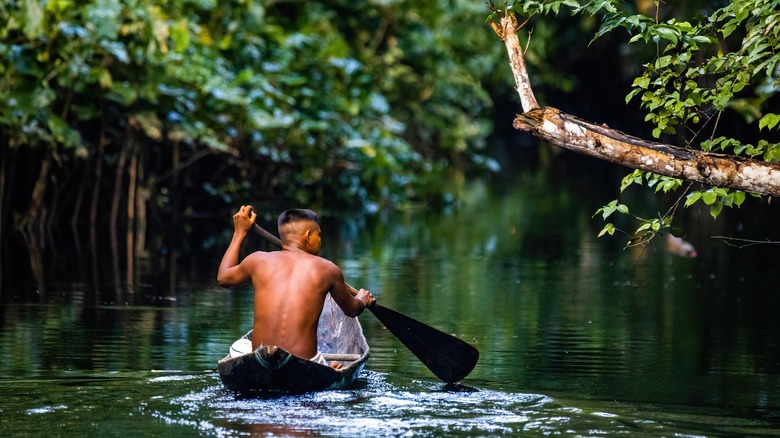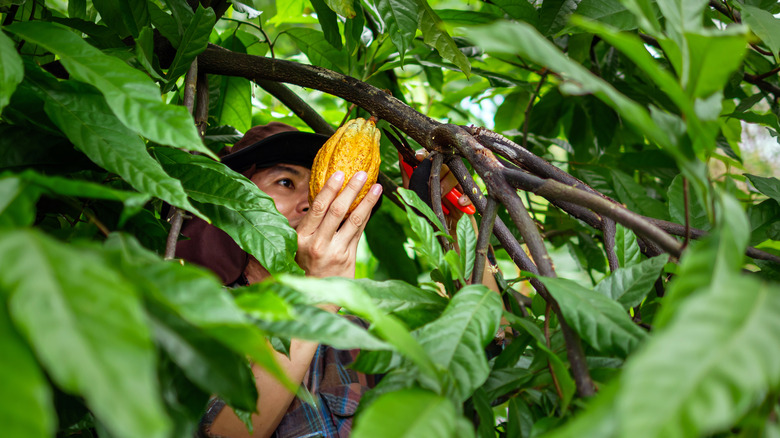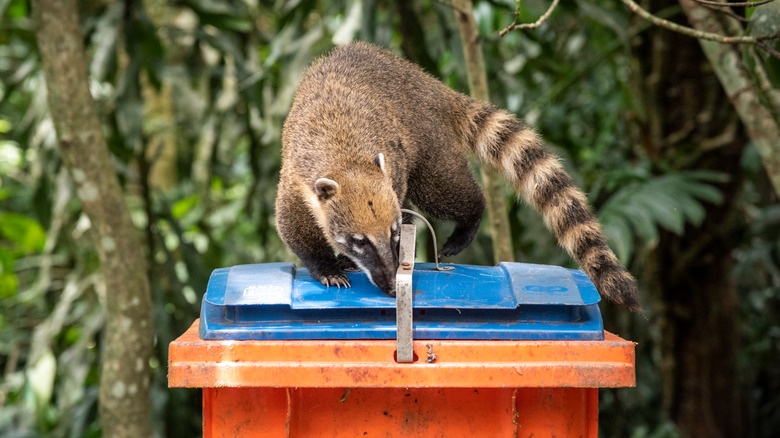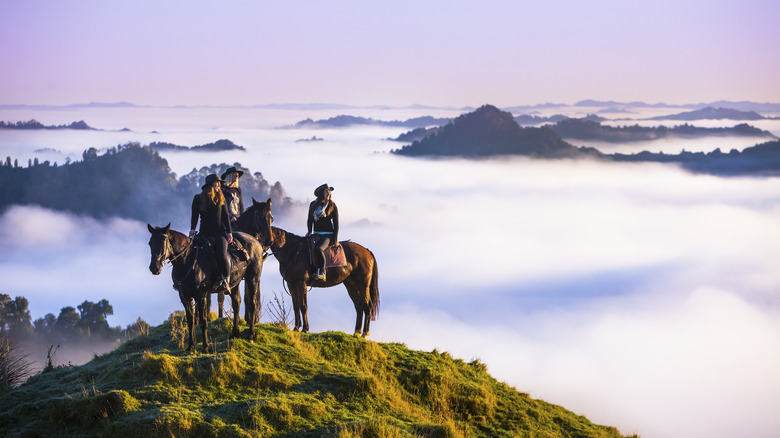11 Things You Should Never Do In The Rainforest
We may receive a commission on purchases made from links.
For some, the idea of another beach vacation in Europe or a vacation filled with tourists, overpriced gelato, and Instagram cliché doesn't cut it anymore. Indeed, there exists a whole raft of would-be explorers willing to eschew the comforts of modern living in pursuit of excitement, danger, and a world of hard-to-define difference. Traveling to the world's most expensive adventure travel destinations compete for attention with bucket list hikes to places like Europe's tallest active volcano, hiking holidays in Australia's Blue Mountains, and weeklong camel rides through the Sahara.
Tropical rainforests, surely, are the ultimate test of a person's willingness to go off the beaten track. Around 8% of the world is covered in such jungles. The Amazon is the largest of these by far, over three times the size of its nearest competitor, the Congo Rainforest. Not that it's all about size. Each rainforest, from the jungles of Borneo to the Guinean forests of West Africa and the remote regions of the Australian hinterlands, presents unique challenges.
And while no two forests are alike, there remain a few golden rules that cut across geographical lines. Here then, are some of the things that you should never do when traveling in a rainforest.
Don't go anywhere without a guide
The first rule is the most important one of all: You should never enter a rainforest on your own. You will always be safer in pairs, and at least one fellow traveler should be an experienced guide who knows the area well.
The risk to life in the rainforest is a serious one and danger sometimes comes from unexpected quarters. In 2023, for example, over 8,000 people died in the Amazon due to the "escalating violence and lawlessness plaguing the area," according to the Brazilian Forum of Public Security (FBSP). Criminal gangs taking advantage of the lack of police presence — the Amazon sports one police officer per 2,451 square kilometers — control known areas of the forest.
Of course, people are not the only danger you might face. The risk of becoming disorientated even a short way into the forest is a very real possibility, and stories of those who did manage to find their way out are harrowing, to say the least.
Trained guides usually operate from a starting camp or lodge and take tourists on a well-established loop through the forest. It's still very much off the beaten track, but the goal is to avoid known hazards such as flood plains, illegal foresting hubs, and Indigenous people who would much rather be left alone. Rangers know what equipment is needed for the trek and, in case of an unforeseen event, can call for backup.
Don't think any old clothing will do
Choosing the correct clothing is super important in the rainforest. You're going to want to be both cool and dry.
Getting these things wrong in the forest is a tale of two miseries. Firstly, there is the heat and humidity itself. Tropical rainforests are warm all year round. The forests of the Amazon basin, for example, maintain an average temperature of around 77 degrees Fahrenheit, but this climbs as high as 104 degrees during the dry season. These temperatures pair rather unpleasantly with high levels of humidity, creating the kind of sweat-that-sticks-your-clothes-to-your-back scenario that is going to keep you up at night. Such humidity can even affect electronics, which are best kept in plastic zip-lock bags when not in use.
Long-sleeved cotton shirts — more on the reason for sleeves later— are the order of the day, as are long trousers. Socks are going to get wet, so keeping at least one dry pair to wear at night is an absolute must. You'll also need a hat to keep the sun off and protect your neck and hair from unwanted, crawling visitors. Also, it's called a rainforest for a reason, and even in the dry season you can expect some 200 millimeters of rain per month. A good quality set of waterproofs is essential.
Add sunglasses, and warm clothing to wear at night, and all that is required are specialty items that you really won't want to do without. First up are the leech socks that pull up over your trousers. Next are the crawler guards that wrap tarpaulin-like over your shoes to prevent any unwelcome surprises in the morning.
Don't use the bathroom at night
When you have to go, you have to go, but when it comes to traveling through the rainforest, there's a definite argument for holding off major ablutions until first light. Not all tours into the rainforest are alike. Some excursions take you from lodge to lodge offering sightseeing opportunities whilst also allowing for modest amounts of creature comforts come nightfall. Most are not like this at all; camps are made at the end of the day, a latrine ditch is dug, and members of the expedition are expected to act like bears when it comes to the movement of bowels.
The problem is that such bodily motions present one of the few times in a rainforest where you're going to need a little privacy, and that creates added complications at night. Firstly, you're going to leave the safety of the camp armed only with a flashlight and a sense of urgency. Second, if everyone else is asleep, nobody will know you have gone until morning. Lastly, the rainforest is filled with things that most assuredly go bump in the night, and advertising your presence with a flashlight is rarely a good idea. More on that later.
Tackling major bodily imperatives during the day — or at least before bedtime — is good practice. At night, urinating in a bottle or Shewee might strip you of a little dignity, but weighed against the realities of an extra-camp jaunt through a pitch-black forest, it is a minor inconvenience at best.
Don't skimp on insect protection
There are, in the Amazon alone, close to 100,000 different species of invertebrates and almost none of them are welcome additions to your personal attire. Most are a little worse than a harmless annoyance — some are a great deal more than that.
The most immediate concern is, of course, the mosquito. During the rainy season — but present year-round regardless — mosquitoes are relentless. They are also vectors for disease, most notably malaria. Found on every continent apart from Antarctica, precautions must be taken irrespective of the specific forest you are exploring. They are most active at night and prefer to feed from stationary targets, so mosquito nets – weighed down with clothing at the periphery are an absolute must. Indeed, the desire to stay within the net at night is just one more reason not to get up and use the toilet. During the day, head nets are a godsend.
There are, of course, other small creatures to deal with on the trail. Some bite, some sting, and, in most cases, if they do so, you'll probably face pain no worse than a bee sting. But make no mistake, exceptions to this rule are plentiful. Prevention is, by far, your best defense.
Insect repellent works in tandem with loose-fitting long-sleeved clothing to keep the worst of them at bay, but it's important to come prepared with tropical strength repellents known as DEET. Clothes designed to keep insects away are very much a thing — as we saw with the crawler guards — but a spray known as Permethrin can be used to treat clothing, bedding, and nets before you even enter the forest.
Don't touch anything that does not need to be touched
Everything you encounter in the forest was forged in the crucible of evolution, carving out a niche for itself in a world filled with aggressive predators, hidden dangers, and the cold indifference of Mother Nature. The living things of the forest have not survived by accident. All have some kind of protection, be that a sting, wings, bites, venomous skin, or camouflage.
That last one is most likely to get you in trouble. The guide(s) will cut the principal trail, so there's usually a path to follow, but low-hanging branches might bar your way, and brushing them aside or — on rough ground — steadying yourself on a nearby tree is often a matter of reflex. The rainforest is a wonderful place to unlearn such behavior.
There are poison dart frogs to worry about in the Amazon, even though their bright coloration serves as adequate warning for most. In Australia — land of the most dangerous wildlife — the gympie-gympie tree doles out one of the most painful stings known to man by touch alone. And then there are all manner of spiders — the Brazilian wandering spider has a particularly nasty bite — snakes, ants, and other small creatures that want nothing more than to be left alone but will react accordingly if you accidentally lay a hand on them.
With that in mind, your machete should be thought of as an extension of your arm. Its principal use of cutting a literal path through the forest is joined by its roles in pushing aside foliage.
Don't assume you aren't being hunted
We've already looked at the insect population of the Amazon, but it's home to a wealth of other creatures as well. There are at least 1,300 types of birds, some 400 amphibians, an impressive 427 mammals, and around 3,000 species of fish.
True, not all rainforests have large predators, but most do, and large cats are every bit as dangerous as you think they are in the quiet moments of the night when the trees begin to rustle. To start with, they know you are easy prey, especially if you've been foolish enough to separate from the group. Second, they love to hunt and sometimes toy with prey even when not particularly hungry. Amazonian jaguars have been known to attack and kill humans.
Elsewhere, there are leopards to deal with, prowling tigers, and even the occasional puma. Their excellent vision, hearing, camouflage, and agility mean that they'll most likely see you before you see them, and their presence is yet one more reason to never venture out alone.
Don't go for a swim
There are safe places to swim in a rainforest, but such locations should be guide-approved and may only be accessible at certain times of the year, as water contains many hidden dangers. What those dangers are depends mostly on which rainforest you are traveling through. In the Amazon, there are plenty of dangerous animals you wouldn't want to encounter in the water. In Australia and elsewhere, their much larger cousin, the saltwater crocodile, does much the same. In 2023,132 people lost their lives to saltwater crocodile attacks.
The waters themselves aren't any safer. Green anacondas can reach 30 feet in length, and although there are no confirmed reports of them killing humans, they are still best avoided. The red-bellied piranha's reputation for feeding frenzies is, thankfully, a Hollywood myth. At the same time, tall tales of fish swimming up urine streams are no less fanciful, but electric eels proliferate in Amazonian waters, and their shock is strong enough to bring on a heart attack. Oh, and there are sharks in the river — angry ones.
Outside of the Amazon basin, there are other threats to consider. Tropical Australia has a growing hookworm problem. There are other water-born parasites, such as the trematode worms found all over East Africa, an area that includes one of the world's most biologically diverse but dangerous parks, the Congo rainforest, and the tropical Kakamega region in Kenya.
Don't forget to take your meds
If ever there was a no-brainer when it comes to traveling through a rainforest, remembering to protect yourself from disease is up there. Vaccinations pre-travel are essential — indeed, in some cases, you won't be allowed to enter a country without proof of vaccination. For a trip to the Amazon, the list includes rabies shots, typhoid, and yellow fever, alongside Hepatitis A and B vaccinations.
Of course, different parts of the world have other illnesses to worry about, and what these are should be thoroughly investigated before setting off. Regardless, in most scenarios, malaria is going to be a legitimate concern. Bite prevention is, as we have seen, at the forefront of your defense against this unpleasant disease, but in high-risk areas, anti-malarial tablets should be taken before you even set off and taken regularly throughout your stay. And, of course, consulting a healthcare professional when it comes to what meds you should be taking is an absolute must.
Don't eat or drink anything you didn't bring with you
Rainforests are under threat across the globe and the last thing you want to do is find yourself damaging it in any way. Don't think you recognize a plant from home, and even if you do, don't eat it. The cocoa beans you spy en route are of no use to you, and at any rate, belong to the forest, local population, or the animals that live there. Guides know what can and cannot be eaten, and it's not unheard of to catch something in the river and eat it on the trail, but such instances are rare and are wholly reliant on the expertise of the individual ranger.
In some instances, rainwater can be collected and purified, but again, only the guide should make this call, and you should always assume any standing water you find is contaminated. You may be heading to a watering hole so that you can fill up canteens with (purified) water for the trip home, but regardless, no guide is going to take you on a trip without ensuring you have enough water, so drinking from your canteen is best.
Food is best served piping hot to ensure nothing is crawling around in it. Meals are usually included in the price of your tour, but it's often a good idea to take along some hiking snacks to keep your energy up.
Don't take souvenirs
Finding a cool-looking snakeskin or the carapace of a long-dead beetle is one of those occurrences that sometimes happens on the trail, but such objects belong to the forest. There are laws protecting certain species, and you might be fined for taking something with you; other governments might consider certain items biohazards, so if you're thinking of taking some flowers to press when you get home, don't. You aren't supposed to be touching anything anyway!
The same goes for things people try to sell you. Don't buy animal products from locals or products made from wood or other forest items; they may have been made from endangered trees or vines. Indeed, the only thing you should take from the forest are your memories of the trip itself. A picture of an exciting discovery is worth just as much as a physical representation and comes with the satisfaction of knowing that your path through the jungle was an ethical one.
Don't disrespect the forest
Littering, unwarranted destruction of fauna, and hunting, capturing, or killing animals, including insects, is an absolute no-no and, in some cases, illegal. The rainforest is home to many, many endangered species, and that includes the creepy crawlers.
Unless your life is threatened, it's important to remember that you are in their world. Snakes are to be avoided, not hacked at with a blade; insects should be brushed off clothes or stepped over, not squished. The same goes for flora; leave it be. The guide knows what they can cut through and what to avoid. Feel free to take a picture of any exotic animals, flowers, or plants you encounter, but walk around or step over them if at all possible.
As you make your way through the forest, take stock of your inventory. The hacked path will heal itself in a matter of weeks, if not days, but any litter you leave behind is a permanent remnant of your disrespect for the environment.
Methodology
This list mostly comes from personal experience — I've been to the Amazon and know the tropical parts of Australia well — but I've also done my due diligence and checked memories against expert advice. Other rainforests I have visited include Borneo and the wilds of Madagascar. Each one offered unique challenges and I've tried to include these in this list. In some cases, flora is often more of a problem than fauna. In others, mosquitos represent the principal threat, with other wildlife taking a backseat. In all cases, it's important to travel with someone who knows what they are doing. Despite my many adventures, I have never entered a rainforest without a local guide. The advice presented here has been cross-referenced with their expertise.
